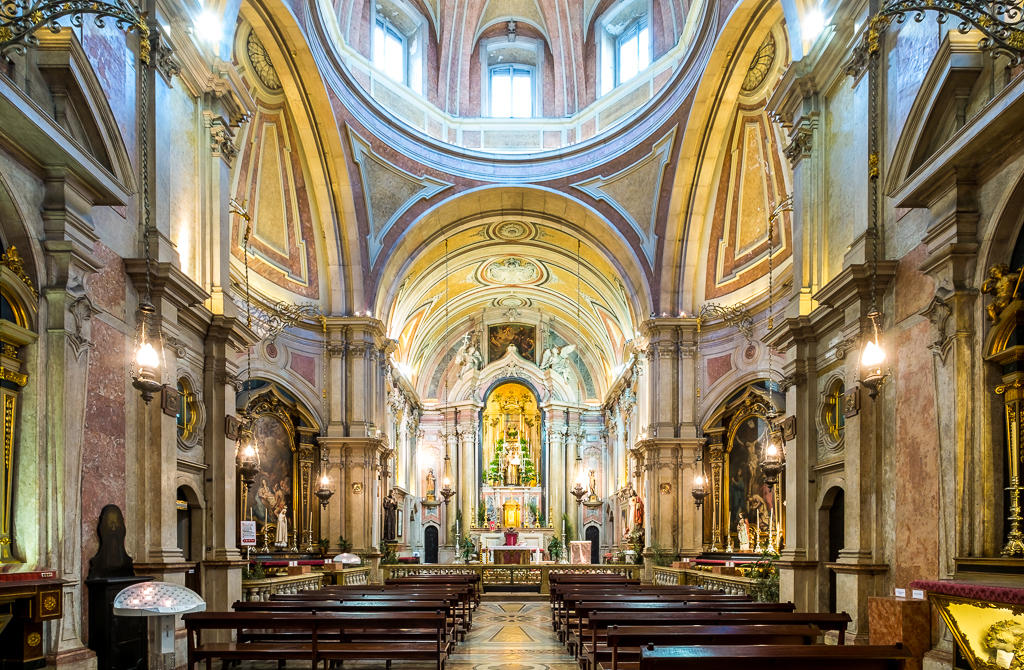The original building on the site of Saint Anthony's birthplace was a small chapel constructed in the 15th century. Unfortunately, nothing remains of this early structure. However, in the early 16th century, during the reign of King Manuel I of Portugal, the chapel was rebuilt. Adjacent to the chapel, the Lisbon Senate was located, showcasing the church's significance and connection to the local community. In the 16th century, a religious brotherhood called the Irmandade de Santo António was founded, dedicated to honoring and venerating Saint Anthony.
In 1730, under the patronage of King John (João) V of Portugal, the Church of Saint Anthony underwent a significant reconstruction and redecoration. However, the devastating 1755 Lisbon earthquake struck, leaving only the main chapel standing. The church was then rebuilt after 1767, thanks to the vision of architect Mateus Vicente de Oliveira. The reconstruction followed a Baroque - Rococo design, showcasing sinuous lines and intricate details, which can still be admired today.
The church's architecture exudes grandeur and elegance. The frontispiece and staircase display distinctive curved lines, typical of the late Baroque and Pombaline styles. Every detail, from the ornate façade to the elaborate interiors, reflects the craftsmanship and artistic expression of the time.
The Church of Saint Anthony holds a special place in the hearts of the people of Lisbon. Every year on June 13th, the feast day of Saint Anthony, a grand procession takes place, starting from the church and passing by Lisbon Cathedral. The procession winds its way through the enchanting slopes of the Alfama neighborhood, a vibrant and historic area near the church. This event is part of the "Popular Saint Festivities", a cherished tradition in Lisbon. During the morning of the festivities, special bread is given to the oldest women of each family, symbolizing blessings and abundance.
The Church of Saint Anthony received a significant honor in May 1982 when Pope John Paul II visited the church. During his visit, he inaugurated a statue of Saint Anthony, sculpted by Soares Branco, in the square in front of the church. The pope also prayed in the crypt, which marks the spot where Saint Anthony was believed to have been born. This papal visit further cemented the church's status as a place of deep spiritual significance and pilgrimage.
Stepping inside the Church of Saint Anthony, visitors are greeted by a sense of serenity and reverence. The interior showcases exquisite artwork, architectural details, and devotional elements. The crypt, accessible through the sacristy, is all that remains of the original church destroyed by the 1755 earthquake. The present-day church, with its late Baroque and Pombaline features, was initiated in 1767 and underwent renovations in 1995 for the saint's 800th anniversary.
Lisbon.vip Recommends
Adjacent to the church, an annex building houses Museum of Saint Anthony (Museu de Lisboa - Santo António), which provides further insights into the life and legacy of Saint Anthony. Renovated in 2010-2012 by a team of experts, including Ana Cristina Leite, Pedro Teotónio Pereira, and Rita Fragoso de Almeida, the museum offers a comprehensive exhibition. Visitors can explore artifacts, religious objects, and artworks that shed light on the saint's journey, teachings, and the impact he had on the local community.
The Church of Saint Anthony of Lisbon stands as a beacon of faith, history, and cultural heritage in the heart of the city. As a touristic destination, it offers visitors a remarkable experience, allowing them to immerse themselves in the captivating story of Saint Anthony and the rich traditions of Lisbon. From the origins of the church on the saint's birthplace to its stunning Baroque-Rococo architecture, every step taken within its walls is a testament to devotion and the enduring legacy of a beloved saint. A visit to the Church of Saint Anthony of Lisbon is not only a journey through history but also a pilgrimage of the soul, leaving visitors with a profound appreciation for faith, artistry, and the power of spiritual devotion.
Map View



